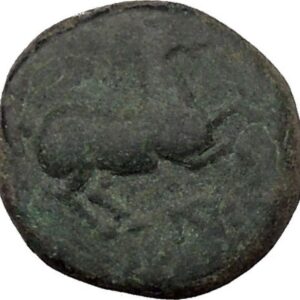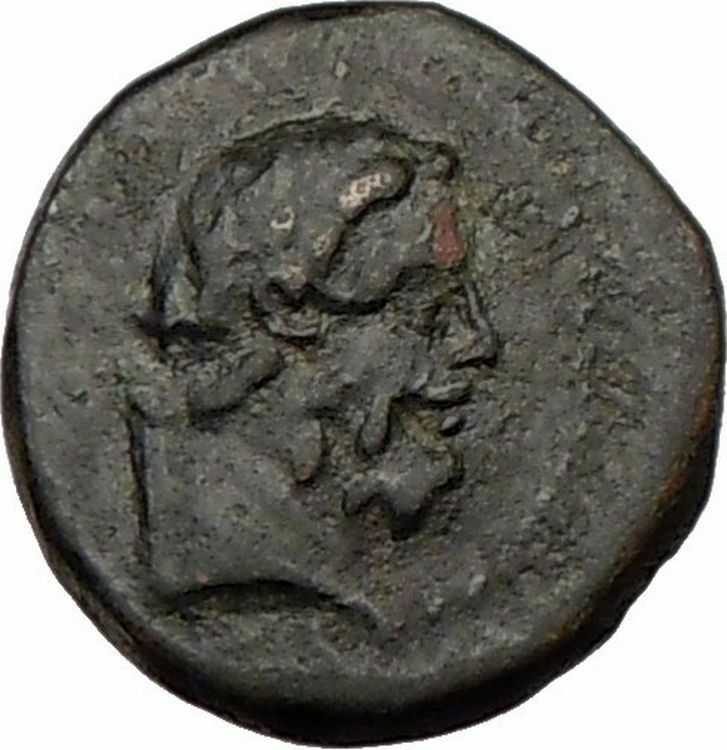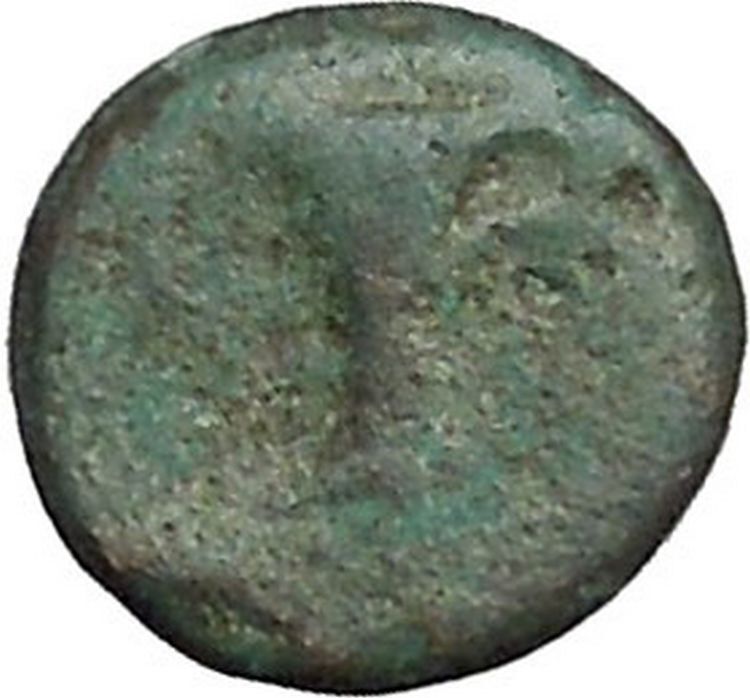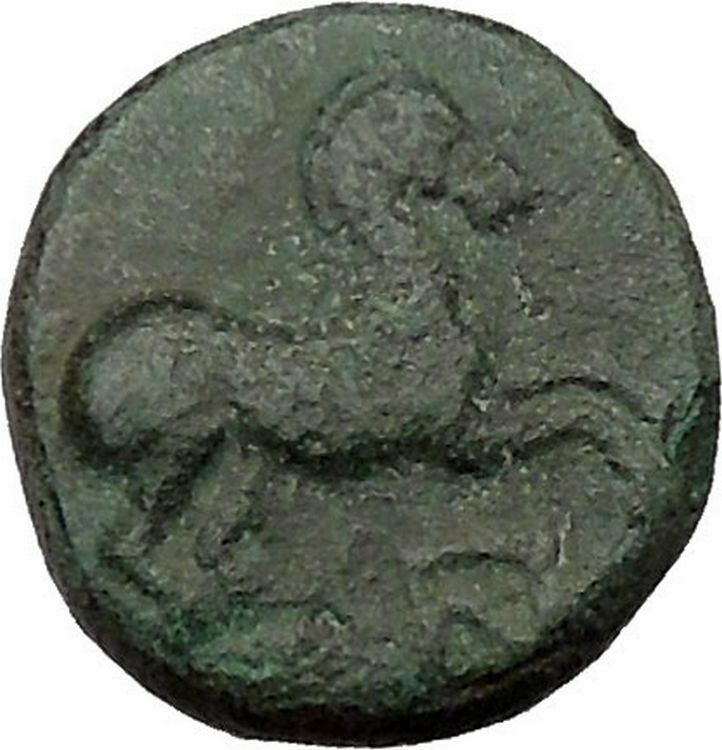|
Arab Kingdom of
Nabataea
Aretas IV – King: 9 B.C. – 40 A.D.
Aretas IV, with Shaqilath
Bronze 15mm (1.63 grams) Petra mint, circa 11-40 A.D.
Reference: Meshorer, Nabataea 97
Aretas standing facing, head left, wearing military attire, holding spear and
placing
hand on hilt of sword;
palm frond to left, monogram to right.
Shaqilath standing left, raising hand; wreath to left; to right, name in Aramaic
in three lines.
The north-Arabian kingdom of the Nabataeans, with their capital at Petra,
continued in existence until the early years of the 2nd Century A.D., when
emperor Trajan created the Roman province of Arabia.
Originally named
Aeneas, he seized the throne on the death of Obodas III and thereafter styled
himself Aretas Philopatris. His daughter married Herod Antipas, whose territory
he later invaded without Roman permission, 37 A.D. However, he managed to obtain
the favor of Caligula who granted him control of Damascus.
You are bidding on the exact item pictured,
provided with a Certificate of Authenticity and Lifetime Guarantee of
Authenticity.
Shaqilath is the daughter of
Aretas IV
of the
Nabataeans
. She ruled jointly with her
husband-brother
Malichus II
(40-70). After his death
she was regent for her son
Rabel II
.
Copper and silver coins
where she is
depicted with her husband and coins of her with her son have been
recovered. Some of these coins are dated with regnal years to the left
of the queen.
Aretas IV Philopatris was the
King of the Nabataeans
from roughly 9 BC to AD 40.
His full title, as
given in the inscriptions, was “Aretas, King of the Nabataeans, Friend of his
People.” Being the most powerful neighbour of
Judea
, he
frequently took part in the state affairs of that country, and was influential
in shaping the destiny of its rulers. While on not particularly good terms with
Rome – as intimated
by his surname, “Friend of his People“, which is in direct opposition to
the prevalent φιλορώμαις (“Friend of the Romans“) and φιλόκαισαρ (“Friend
of the Emperor“) – and though it was only after great hesitation that
Augustus
recognized him as king, nevertheless he took part in the expedition of
Varus
against the Jews in the year 4 BC, and placed a considerable army at
the disposal of the Roman general.
His daughter
Phasaelis
married
Herod
Antipas
(4 BC – AD 39), otherwise known as Herod the Tetrarch. When Herod
divorced Phasaelis to take his brother’s wife
Herodias
,
mother of Salome
,
in 36, Phasaelis fled to her father. Relations between Herod and Aretas IV were
already strained over border disputes, and with his family honour shamed, Aretas
IV invaded Herod’s holdings, defeating his army
and capturing territories along the
West Bank
of the Jordan River
, including the areas around
Qumran
.
The classical author
Josephus
connects this battle, which occurred during the winter of AD 36/37, with the
beheading of
John the Baptist
, which occurred about the same time.
Herod Antipas
then appealed to Emperor
Tiberius
,
who dispatched the governor of Syria to attack Aretas. But because of the
emperor’s death in AD 37 this action was never carried out.
The Christian Apostle,
Paul
, mentions that he had to sneak out of Damascus in a basket through a
window in the wall to escape King Aretas. (2
Corinthians 11:32, 33, cf
Acts
9:23, 24).

Al Khazneh or The Treasury at Petra
|
Petra (Arabic:
البتراء, Al-Batrāʾ;
Ancient Greek
: Πέτρα) is a
historical
and
archaeological
city in the southern
Jordanian
governorate of
Ma’an
that is famous for its
rock-cut architecture
and water conduit system.
Another name for Petra is the Rose City due to the color of the stone out of
which it is carved.
Established possibly as early as 312 BC as the capital city of the
Nabataeans
, it is a symbol of Jordan, as well
as Jordan’s most-visited tourist attraction. It lies on the slope of
Jebel al-Madhbah
(identified by some as the
biblical Mount Hor
[4])
in a
basin
among the mountains which form the
eastern flank of Arabah
(Wadi Araba), the large valley running
from the Dead Sea
to the
Gulf of Aqaba
. Petra has been a
UNESCO
World Heritage Site
since 1985.
The site remained unknown to the
Western world
until 1812, when it was
introduced by
Swiss
explorer
Johann Ludwig Burckhardt
. It was described as
“a rose-red city half as old as time” in a
Newdigate Prize
-winning poem by
John William Burgon
. UNESCO has described it as
“one of the most precious cultural properties of man’s cultural heritage”. See:
UNESCO Intangible Cultural Heritage Lists
.
Petra was chosen by the
Smithsonian Magazine
as one of the “28
Places to See Before You Die”.
The Nabataean kingdom, also named Nabatea(Arabic:نبطية) (many
times spelled Nabatean), was an Arabic political state of the
Nabataeans
which existed during
classical antiquity
and was annexed by the
Roman Empire
in CE 106.
Geography
Located between the
Sinai Peninsula
and the
Arabian Peninsula
, its northern neighbour was
the kingdom of Judea
, and its south western neighbour was
Ptolemaic Egypt
. Its capital was the city of
Petra
in
Jordan
, and it included the towns of
Bostra
,
Mada’in Saleh
, and
Nitzana
.
Petra was a wealthy trading town, located at a convergence of several
important trade routes
. One of them was the
Incense Route
which was based around the
production of both myrrh
and
frankincense
in southern Arabia, and ran
through Mada’in Saleh to Petra. From here the aromatics were distributed
throughout the Mediterranean region.
History
Nabataean origins date from a time when they were nomadic pastoralists in the
Negev
and the
Sinai Peninsula
during
Achaemenid Persian
rule, around the 4th century
BCE.
Nabateans and
Hasmoneans
The Nabataeans were allies of the first
Hasmoneans
in their struggles against the
Seleucid
monarchs. They then became rivals of
the Judaean dynasty, and a chief element in the disorders which invited
Pompey
‘s intervention in
Judea
. Many Nabataeans were forcefully
converted to Judaism
by the
Hasmonean
king
Alexander Jannaeus
. It was this King who, after
putting down a local rebellion, invaded and occupied the Nabataean towns of
Moab and Gilead
and imposed a tribute of an unspecified
amount. Obodas I
knew that Alexander would attack, so
was able to ambush Alexander’s forces near Gaulane (Golan)
destroying the Judean army in 90 BCE. Under the reign of
Aretas III
(87 to 62 BCE) the kingdom seems to
have reached its territorial zenith, but was defeated by a Roman army under the
command of
Marcus Aemilius Scaurus
. Scaurus’ army even
besieged Petra, but eventually a compromise was negotiated. Paying a tribute,
Aretas III received the formal recognition by the
Roman Republic
.
The Nabatean kingdom saw itself slowly surrounded by the expanding
Roman Empire
, which conquered Egypt and annexed
Hasmonean Judea. While the Nabatean kingdom managed to preserve its formal
independence, it became a client kingdom under the influence of Rome.
Roman annexation
A map of the
Roman Empire
, at its greatest
extent, showing the territory of Trajan’s Nabatæan conquests in the
southeast.
Main article:
Arabia Petraea
In 106 CE, during the reign of Roman emperor
Trajan
, the last king of the Nabatean kingdom
Rabbel II Soter
died. This event might have
prompted the official annexation of Nabatea to the Roman Empire, although the
formal reasons, and the exact manner of annexation, are unknown.
Some epigraphic evidence suggests a military campaign, commanded by
Cornelius Palma
, the governor of
Syria
. Roman forces seem to have come from
Syria and also from
Egypt
. It is clear that by 107 CE Roman legions
were stationed in the area around Petra and Bostra, as is shown by a papyrus
found in Egypt. The kingdom was annexed by the empire, becoming the province of
Arabia Petraea
. Trade seems to have largely
continued thanks to the Nabataens’ undiminished talent for trading.
Under Hadrian
, the
limes Arabicus
ignored most of the Nabatæan
territory and ran northeast from Aila (modern
Aqaba
) at the head of the
Gulf of Aqaba
. A century later, during the
reign of
Alexander Severus
, the local issue of coinage
came to an end. There is no more building of sumptuous tombs, owing apparently
to a sudden change in political ways, such as an invasion by the neo-Persian
power under the
Sassanid Empire
.
The city of Palmyra
, for a time the capital of the
breakaway
Palmyrene Empire
(fl. 130–270), grew in
importance and attracted the Arabian trade away from Petra.
See also
-
List of rulers of Nabatea
- Nephesh
|










